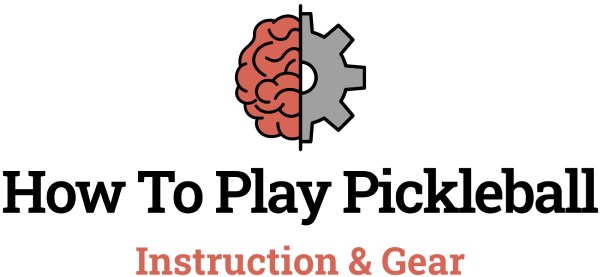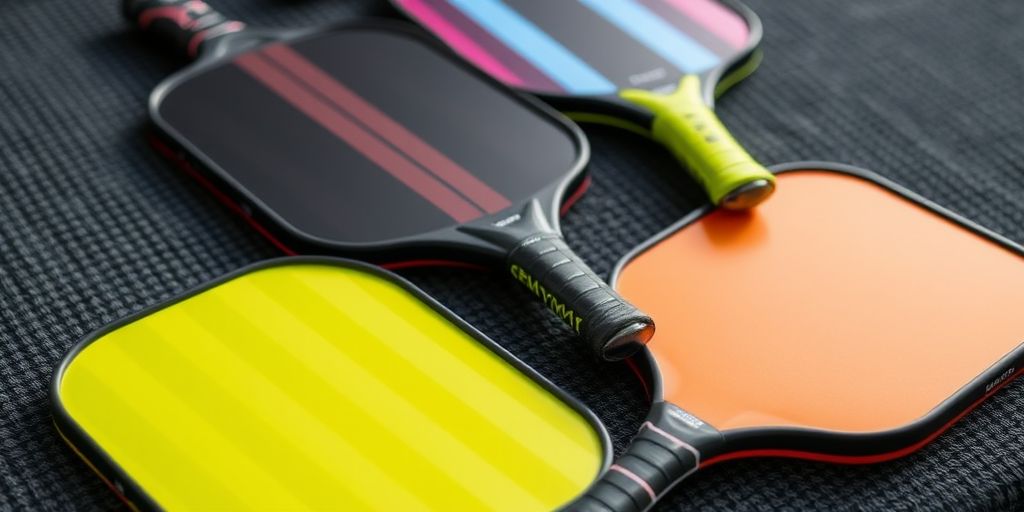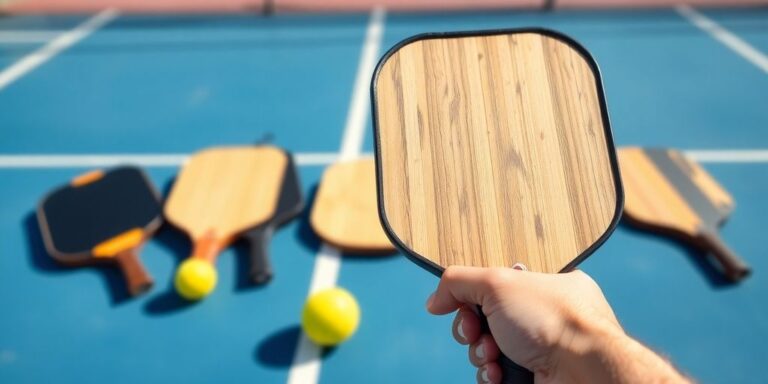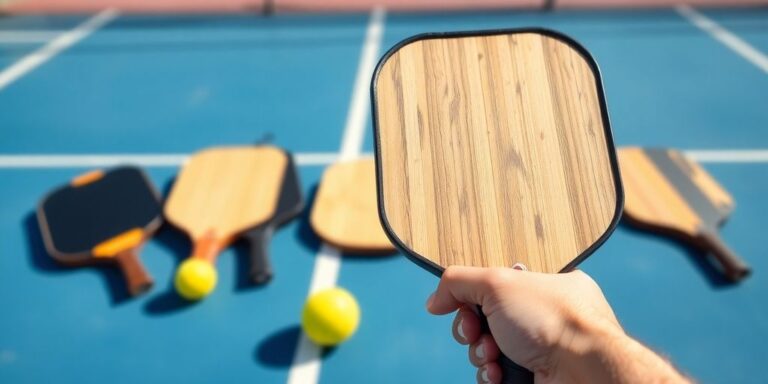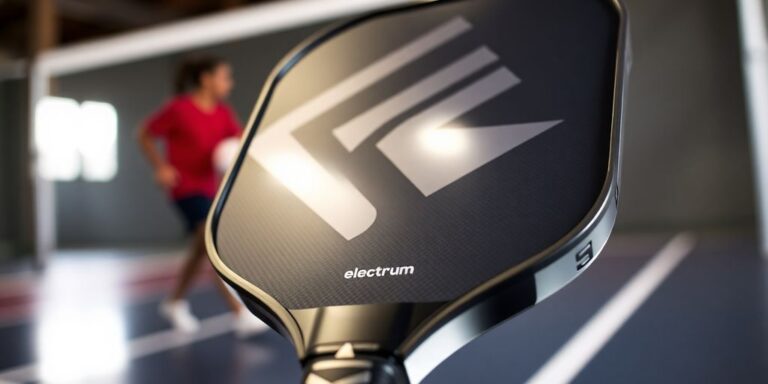In the fast-growing world of pickleball, professional players are not just competing; they are also setting trends with their gear. As the sport gains more attention, many enthusiasts wonder, “What pickleball paddle do the pros use?” This article dives into the paddles favored by top players in 2025, showcasing their choices and what makes these paddles stand out. Whether you’re a seasoned player or just starting, understanding what the pros use can help you find the right paddle for your game.
Key Takeaways
- Top pros like Ben Johns and Simone Jardim use paddles designed for their unique playing styles.
- Brands like Selkirk and JOOLA are highly favored among professional players for their quality and performance.
- Pro paddles tend to feature advanced materials and designs that enhance spin, power, and control.
- Understanding features like weight, grip size, and material can help you choose a paddle that suits your style.
- Emerging technologies, such as smart paddles and eco-friendly materials, are shaping the future of pickleball equipment.
Top Professional Players And Their Paddles
Ben Johns – JOOLA Perseus 3S
When you talk about pro pickleball, you have to start with Ben Johns. He’s pretty much the face of the sport right now. He uses the JOOLA Perseus 3S, and it’s a big deal. It’s designed for power and control, which is exactly what you see in his game. It’s not just hype; this paddle really does seem to help him dominate on the court. I’ve heard people say that affordable pickleball paddles can get you close to the pro experience, but there’s something about the Perseus 3S that sets it apart.
Simone Jardim – Selkirk Vanguard
Simone Jardim is a legend, and she trusts the Selkirk Vanguard. This paddle is known for its balance and feel. It lets her place the ball exactly where she wants it. It’s interesting how different pros choose different paddles based on their style. Jardim’s game is all about precision, and the Vanguard seems to be a perfect fit. The rise of pickleball players in 2024 has definitely influenced paddle design, with more emphasis on control and finesse.
Tyson McGuffin – Gearbox GX5
Tyson McGuffin brings the heat with the Gearbox GX5. This paddle is all about power. If you watch Tyson play, you know he likes to hit the ball hard, and the GX5 helps him do just that. It’s built for speed and aggression. It’s interesting to see how pros like McGuffin use their equipment to amplify their natural strengths.
It’s not just about the paddle, though. These pros put in the hours of practice and training. The paddle is just a tool, but it’s a tool that’s been carefully chosen to match their individual needs and playing style.
Popular Paddle Brands Among Pros
It’s interesting to see which brands dominate the pro scene. While player skill is obviously the biggest factor, equipment matters, and certain brands have clearly earned the trust of top-tier athletes. Let’s take a look at some of the most popular choices.
Selkirk – The Choice of Champions
Selkirk is a major player, and it’s not hard to see why. They’ve consistently pushed the boundaries of paddle technology, and their paddles are known for quality and performance. Selkirk invests heavily in research and development, and it shows. They are known for putting project paddles in players’ hands to test extensively. For example, the Selkirk Labs Project 003 is currently the 3rd most expensive paddle in the world. Selkirk is a brand that many pros trust.
- Innovative technologies
- High-quality materials
- Extensive player testing
JOOLA – Innovation and Performance
JOOLA has made a big splash in recent years, quickly becoming a favorite among pros. They’ve got a reputation for paddles that deliver both power and precision. The brand is known for its sleek designs and cutting-edge materials. JOOLA is a brand that is constantly innovating. They are known for their best pickleball paddles.
Paddletek – Trusted by Many
Paddletek has been around for a while, and they’ve built a solid reputation for reliable, high-performing paddles. They might not always be the flashiest brand, but their paddles are known for their durability and consistent performance. Paddletek is a brand that many pros trust. They are known for their pickleball clubs.
It’s worth noting that sponsorships play a role here. Pros often have endorsement deals, but they wouldn’t align themselves with a brand that doesn’t deliver quality. These brands have earned their place through performance and reliability, making them go-to choices for players at the highest level.
Key Features Of Pro-Level Paddles
When you’re looking at the paddles the pros use, it’s not just about the brand name. There are some key features that really make a difference in how a paddle performs. Let’s break down what to look for.
Material Composition
The materials used in a paddle’s construction have a huge impact on its performance. Most pro-level paddles use a combination of materials to optimize power, control, and feel. You’ll often see carbon fiber faces paired with polymer or composite cores. Carbon fiber provides stiffness and responsiveness, which translates to power and spin. The core material affects the paddle’s feel and control. For example, a T700 carbon fiber face is common in high-end paddles.
Weight and Balance
Weight and balance are super important for how a paddle feels in your hand and how easy it is to maneuver. Pros usually have very specific preferences when it comes to weight. Some like a heavier paddle for more power and stability, while others prefer a lighter paddle for faster hand speed and quicker reactions. The balance point also matters – a head-heavy paddle will feel more powerful, while a head-light paddle will feel more maneuverable. Understanding these trade-offs is essential for choosing the right paddle.
Grip Size and Comfort
The grip is your connection to the paddle, so it needs to feel just right. Grip size is crucial – too small, and you’ll be squeezing too hard; too big, and you’ll lose control. Most players can figure out their ideal grip size with a simple measurement. Comfort is also key. Look for grips that are cushioned and absorbent, so your hand doesn’t get tired or sweaty during long matches. Some grips even have textured surfaces for better tackiness. The GoSports GS1 Pickleball Paddle Review highlights the importance of a comfortable handle.
It’s worth noting that many pros customize their grips with overgrips to fine-tune the size and feel. Don’t be afraid to experiment with different grips until you find one that feels perfect for you.
Here’s a quick look at how different weights can affect paddle performance:
| Weight (oz) | Pros | Cons |
|---|---|---|
| 7.5 – 7.8 | Faster hand speed, quicker reactions | Less power, less stability on off-center hits |
| 7.9 – 8.2 | Good balance of power and control | May feel too heavy for some players |
| 8.3+ | More power, more stability | Slower hand speed, more tiring |
Performance Metrics That Matter

Okay, so you’re eyeing a new paddle, maybe even one the pros use. But how do you really know if it’s good? It’s not just about the brand or the price tag. It’s about how it performs. Here’s the lowdown on what to look for:
Spin Potential
Spin is a game-changer. A paddle that lets you generate a lot of spin can make your dinks deadlier and your serves tougher to return. The surface texture and material play a big role here. Rougher surfaces tend to grip the ball better, leading to more spin. I’ve noticed that paddles with carbon fiber faces often excel in this area. It’s not just about the paddle, though; technique matters too. But a good paddle can definitely give you an edge.
Power and Control
This is the big one, right? Everyone wants a paddle that can deliver power when you need it, but without sacrificing control. Finding that balance is key.
Here’s what I’ve learned:
- Weight: Heavier paddles generally offer more power, but can be harder to control. Lighter paddles are easier to maneuver, giving you better control, but might lack some punch.
- Balance: A head-heavy paddle will give you more power, while a head-light paddle will improve your control and reaction time at the net.
- Core Material: The core affects how the paddle transfers energy to the ball. Some cores are designed for power, others for control. Engage Pickleball paddles are known for their balance of both.
Durability and Longevity
Let’s be real, pickleball paddles aren’t cheap. You want something that’s going to last. Look for paddles with edge guards to protect against chips and cracks. The surface material also matters. Some materials are more prone to wear and tear than others. Read reviews and see what other players are saying about the paddle’s durability. I’ve seen some paddles that look great out of the box but fall apart after a few months of regular play. Also, consider how the new rules for pickleball might affect paddle wear and tear.
It’s important to remember that performance metrics are subjective to some degree. What works great for one player might not work as well for another. Your playing style, skill level, and personal preferences all play a role. That’s why it’s always a good idea to try out a few different paddles before making a purchase.
Emerging Trends In Paddle Technology
Pickleball paddle tech is moving fast! It’s not just about slapping some fiberglass on a core anymore. We’re seeing some seriously cool innovations that are changing the game. Let’s take a look at what’s new.
Graphene and Carbon Fiber Innovations
Carbon fiber is getting a serious upgrade with graphene-infused materials. This makes paddles lighter, stronger, and more responsive. Graphene helps distribute the impact across the paddle face, increasing the sweet spot and reducing vibrations. You’ll find that pickleball-like games are now easier to play because of these advancements. It’s not just about power; it’s about control and feel.
Smart Paddles with Sensors
Imagine a paddle that tracks your every swing! Smart paddles are becoming a thing, equipped with sensors that gather data on your game. This data can include:
- Swing speed
- Impact location
- Spin rate
- Paddle angle
This information is sent to an app on your phone, allowing you to analyze your performance and identify areas for improvement. It’s like having a personal coach in your paddle! The future of pickleball is here.
Eco-Friendly Materials
More and more companies are looking at ways to make paddles more sustainable. This includes using recycled materials, bio-based resins, and manufacturing processes that reduce waste. It’s a win-win: you get a great paddle, and you’re helping the environment. The evolution of pickleball paddles is also becoming more eco-conscious.
The push for eco-friendly materials isn’t just a trend; it’s a necessity. As pickleball grows, the demand for paddles increases, so it’s important to minimize the environmental impact of production. Expect to see more brands embracing sustainable practices in the coming years.
Signature Paddles Of Top Athletes
It’s fascinating to see how closely some pros work with brands to develop paddles tailored to their specific needs and playing styles. These signature models often incorporate unique technologies or design elements that reflect the athlete’s preferences. Let’s take a look at some examples.
Ben Johns’ Signature Paddle
Ben Johns, a dominant force in pickleball, has a signature paddle with JOOLA: the JOOLA Perseus 3S. This paddle is engineered to complement his all-around game, offering a balance of power, control, and spin. It features a standard grip thickness of 4 1/4”, a paddle length of 16 1/2”, a core thickness of 16 mm, and a paddle width of 7 1/2”.
Many players find that using a paddle designed for a pro helps them improve their game, even if they aren't at that level yet. It's all about finding the right fit for your style.
Simone Jardim’s Custom Design
Simone Jardim, known for her strategic play, uses the Selkirk Vanguard. The long-time Selkirk Pro now has her own signature paddle with the Selkirk Catherine Parenteau VANGUARD Power Air Invikta Middleweight Carbon Fiber Pickleball Paddle! Packed with power and performance just like her game Catherine Parenteau now has her special edition colorway which makes her paddle stand out from the rest of the players!
Tyson McGuffin’s Preferred Model
Tyson McGuffin, famous for his electrifying style, uses the JOOLA Magnus 3s. Tyson’s signature JOOLA Magnus 3 is one of the most powerful paddles ever created. With groundbreaking technologies, this true player’s paddle bangs balls and features stability for McGuffin-like blocks. It’s a paddle designed for aggressive play and powerful shots. For players looking to add some pop to their game, this could be a good choice. Remember to consider how it fits with your overall competitive pickleball strategy.
Here’s a quick comparison of some key features:
| Feature | Ben Johns (JOOLA Perseus 3S) | Tyson McGuffin (JOOLA Magnus 3s) |
|---|---|---|
| Power | High | Very High |
| Control | High | Medium |
| Spin | High | High |
| Preferred Player | All-around | Aggressive |
When choosing a paddle, think about what aspects of your game you want to emphasize. Do you want more power, or are you looking for better control? Also, consider the best pickleball nets for practice.
How To Choose A Paddle Like The Pros

So, you want to pick a paddle like the pros? It’s not just about grabbing the most expensive one and hoping for the best. It’s about understanding what makes a paddle right for you. Pros spend hours dialing in their equipment, and you can take a page from their book.
Understanding Your Play Style
First things first: what kind of player are you? Do you like to hang back and dink, or are you an aggressive net player? Do you rely on power, or finesse? Knowing your strengths and weaknesses is key. For example, if you’re all about power, you might want to look at power paddles that can really help you drive the ball. If you’re more of a control player, a paddle with a larger sweet spot might be a better fit. Think about how you naturally play and what you want to improve.
Testing Before You Buy
This is huge: demo, demo, demo! Most shops will let you try out paddles before you buy them. Take advantage of this! What feels good in your hand might not translate to good performance on the court. Pay attention to how the paddle feels when you hit the ball. Does it feel comfortable? Does it give you the control you need? Does it have the right amount of pop? If possible, try out a few different paddles with different weights, shapes, and materials. This will give you a better sense of what you like and what works for your game. Consider paddle shape and size when testing different models.
Budget Considerations
Let’s be real, pickleball paddles can get expensive. Pro-level paddles can easily cost over $200. But that doesn’t mean you need to break the bank to get a good paddle. There are plenty of great options in the $100-$150 range. Think about how often you play and how serious you are about the game. If you’re just starting out, you might want to go with a more affordable paddle until you figure out what you really want. You can always upgrade later. Here’s a simple breakdown:
- Beginner: $50-$100
- Intermediate: $100-$150
- Advanced: $150+
Don’t get caught up in the hype. A fancy paddle won’t magically make you a better player. Focus on improving your skills and finding a paddle that complements your game. The most expensive paddle isn’t always the best paddle for you.
Here are some things to consider:
- Weight: Lighter paddles are easier to swing, but heavier paddles offer more power and stability.
- Grip Size: Make sure the grip feels comfortable in your hand. Too small, and you’ll have to squeeze too hard. Too big, and you’ll lose control.
- Material: Different materials offer different levels of power, control, and spin. Do some research to see what’s right for you.
Choosing the right paddle can make a big difference in your game. To pick a paddle like the pros, think about the weight, grip, and material. A lighter paddle is easier to handle, while a good grip helps you control your shots better. Don’t forget to consider the paddle’s shape and size, as these can affect your performance. For more tips and to find the perfect paddle for you, visit our website today!
Wrapping It Up
So, there you have it. The paddles that the pros are using in 2025 give you a good idea of what to look for if you want to step up your game. While you might not be ready to hit the pro circuit just yet, picking a paddle that suits your style can definitely help. Remember, it’s not just about the paddle; it’s about how you play with it. Whether you’re looking for power, control, or spin, there’s a paddle out there for you. So, go ahead, try out some of these favorites, and see how they feel in your hands. Who knows? You might just find your new secret weapon on the court.
Frequently Asked Questions
What is pickleball?
Pickleball is a fun sport that combines elements of tennis, badminton, and ping pong. You play with paddles and a plastic ball on a court.
Who are the top pickleball players in 2025?
Some of the best players include Ben Johns, Simone Jardim, and Tyson McGuffin. They are known for their amazing skills and techniques.
What makes pro-level paddles different from regular ones?
Pro-level paddles are designed with special materials and features that give players better control, power, and spin. They are made to suit the needs of advanced players.
How do I choose the right pickleball paddle for me?
Consider your playing style, the weight of the paddle, and the grip size. It’s also a good idea to try out different paddles before buying.
Are expensive paddles worth it?
While higher-priced paddles often have better materials and designs, what matters most is how comfortable and effective the paddle feels for your game.
What are some new trends in pickleball paddles?
New trends include paddles made with advanced materials like graphene and carbon fiber, smart paddles with sensors, and eco-friendly options.
